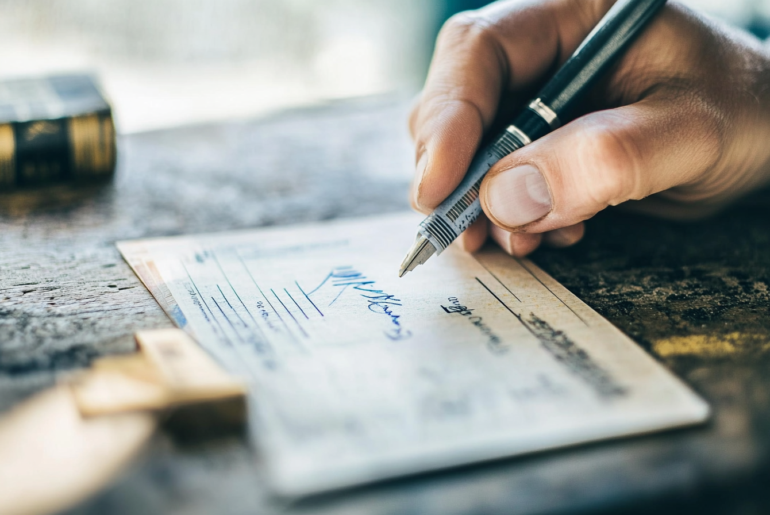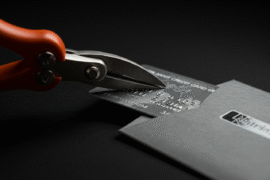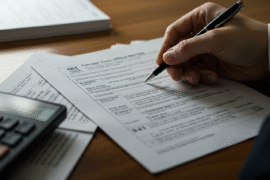This article may contain references to products or services from one or more of our advertisers or partners. We may receive compensation when you click on links to those products or services. Nonetheless, our opinions are our own.
The information presented in this article is accurate to the best of our knowledge at the time of publication. However, information is subject to change, and no guarantees are made about the continued accuracy or completeness of this content after its publication date.
The traditional check may seem outdated where electronic payments are commonplace. However, it is still an important tool in many financial situations. If you know how to write and handle checks properly, you will be prepared for situations when electronic payments fail. You can use them to pay bills, give money, or send gifts. You can protect your money and become more financially literate by learning what each part of a check means, how to fill it out correctly, and how to avoid common mistakes. We’ll tell you everything you need to know, like how to write a check, what parts it should have, and how to keep your checkbook balanced and avoid fraud.
- The Basics of a Check and Its Components
- Gathering the Necessary Information Before You Start
- Step-by-Step Guide to Filling Out a Check Correctly
- Keeping Track of Your Check Payments
- Tips for Safeguarding Your Checks Against Fraud
- Decoding Common Mistakes and How to Avoid Them
- Knowing When and How to Use Checks in Today’s Digital World
- How to Balance a Checkbook
- Conclusion
- Frequently Asked Questions
- Recommended Reads
The Basics of a Check and Its Components
You might not notice all the important parts that make a check work when you look at it. Each part is important for making sure that the transaction goes through correctly and safely. Let’s go over these parts one by one so you can feel more comfortable writing checks.
-
Payee: This is the person or entity to whom you’re making the payment. Always ensure you spell their name correctly to avoid any confusion or delays.
-
Amount in Numbers: Here, you specify the exact amount of money you’re paying, which should be clear and easy to read.
-
Amount in Words: Writing out the amount in words helps prevent any discrepancies, especially if someone mishandles the numerical figure.
-
Date: By putting the date on the check, you indicate when the payment is being made, which is essential for both your records and the payee’s.
-
Signature: Your signature is crucial; it provides authorization for the transaction. Make sure it’s consistent with the signature on file at your bank.
-
Memo Line: This optional space allows you to note the purpose of the payment, making it easier for both you and the payee to track transactions.
These components can empower you to write checks with confidence.
| Component | Description |
|---|---|
| Payee | Who are you paying |
| Amount in Numbers | The numerical payment amount |
| Amount in Words | The written payment amount |
| Date | The issue date of the check |
| Signature | Your authorization |
| Memo Line | Purpose of the payment |
With this knowledge, you’re well on your way to mastering the art of check writing and managing your finances more effectively.
Gathering the Necessary Information Before You Start
Before you put pen to paper and write your check, it’s crucial to gather all necessary information to ensure a smooth transaction. You want to have all your details in front of you, avoiding any last-minute confusion. Here’s what you should collect:
-
The Payee’s Name: Make sure you know exactly whom you’re paying. A small spelling error can lead to delays.
-
Amount in Numbers and Words: Always double-check the amount. Writing it in words helps prevent alteration.
-
Date: Having the correct date is essential; it determines when the check is valid.
-
Memo (if needed): A brief note about what the payment is for adds clarity and keeps your records organized.
-
Your Signature: This is what legitimizes the check, so make sure your signature matches what’s on file with your bank.
Additionally, if you’re writing checks regularly, it may be wise to maintain a checkbook ledger where you track each transaction.
| Date | Payee | Amount | Memo |
|---|---|---|---|
| MM/DD/YYYY | John Doe | $100 | Rent Payment |
| MM/DD/YYYY | Jane Smith | $45 | Utility Bill |
This practice will help you track your spending and keep you accountable for your financial decisions.
Step-by-Step Guide to Filling Out a Check Correctly
Filling out a check correctly is easier than you think. Start by ensuring you have all your documents ready. Then, follow these straightforward steps:
-
Date the Check: Write the current date in the top right corner. This helps both you and the recipient keep track of when the check was issued.
-
Payee Name: On the line that starts with “Pay to the order of,” write the full name of the person or business you are paying. Be precise.
-
Amount in Numbers: In the box next to the payee’s name, write the amount of the check in numerical form. Include cents (e.g., 100.00).
-
Amount in Words: Below the payee line, write out the amount in words. For example, if your check is for $100.00, write “One hundred dollars and 00/100.”
-
Signature: Sign the check on the bottom right line. Your signature verifies that the payment is authorized.
-
Memo Section: If applicable, use the memo line to note the purpose of the check. It’s a great way to stay organized.
Always double-check your entries before handing over the check. Consider keeping a record of the check in a ledger or app to stay on top of your finances and track sent payments.
Keeping Track of Your Check Payments
Keeping track of your check payments is essential for maintaining your financial records accurately. Make sure to note each check you write, including the date, payee, and amount, in your ledger or financial tracking app. This practice will help you stay organized and monitor your expenses effectively. By consistently recording your transactions, you can easily track sent payments, identify discrepancies, and maintain control over your finances.
Voted "Best Overall Budgeting App" by Forbes and WSJ
Monarch Money helps you budget, track spending, set goals, and plan your financial future—all in one app.
Get 50% OFF your first year with code MONARCHVIP
Tips for Safeguarding Your Checks Against Fraud
Taking steps to protect your checks from fraud is very important. Here are some practical steps you can take:
-
Opt for Secure Checks: Use checks made with fraud-resistant materials to help prevent forgery and alterations.
-
Utilize Positive Pay: Many banks offer this service, allowing you to share a list of issued checks with them. If a check is presented that isn’t on the list, they won’t honor it.
-
Be Cautious with Your Information: Avoid sharing sensitive information in public. Don’t leave filled-out checks unattended.
-
Monitor Your Accounts: Regularly check your bank statements for unauthorized transactions. The sooner you catch discrepancies, the better.
-
Use Secure Storage: Keep your checkbook in a safe place at home, such as a locked drawer or file.
If you need to void a check, do it properly.
| Voided Check Format |
|---|
| VOID |
| Your Name |
| Your Address |
| Date: [Insert Date] |
| Pay to the Order Of: [Name] |
| Amount: [Amount] |
By incorporating these tips into your routine, you can reduce your risk of check fraud. Stay vigilant and make these practices a habit.
Decoding Common Mistakes and How to Avoid Them
Several common mistakes can occur when writing checks if you’re not careful.
-
Incorrect Date Format: Use the correct format preferred in your country. In the U.S., it’s typically MM/DD/YYYY. Double-check before finalizing.
-
Amount Mismatch: If the numeric and written amounts don’t match, your check may not be honored. Write both neatly and clearly.
| Numeric Amount | Written Amount |
|---|---|
| $50.00 | Fifty and 00/100 dollars |
| $123.45 | One hundred twenty-three and 45/100 dollars |
| $1,000.00 | One thousand and 00/100 dollars |
-
Missing Signature: Forgetting to sign invalidates the check. Review each section before handing it over.
By implementing these simple but effective strategies, you’ll ensure that your checks are filled out properly and serve their intended purpose without issues.
Knowing When and How to Use Checks in Today’s Digital World
While the digital age has made transactions faster and more convenient, checks still have their place. Consider using checks for:
-
Rent or Mortgage Payments: Many landlords prefer checks for record-keeping and to avoid digital transaction fees.
-
Donations: Giving to charities by check allows for personalization and tracking.
-
Gifts: Checks offer a tangible, formal method for giving money.
When writing a check, keep it clear and double-check the following areas:
| Field | Importance |
|---|---|
| Date | Essential for tracking the payment date |
| Payee Name | Ensures the funds go to the correct recipient |
| Amount in Numbers and Words | Prevents misunderstandings and fraud |
| Signature | Validates your authorization |
Knowing when to use checks and how to fill them out properly helps maintain control of your finances in both traditional and modern contexts.
How to Balance a Checkbook
Balancing your checkbook is essential to track and manage your spending accurately. Follow these steps:
-
Record all transactions: Write down every deposit, withdrawal, and purchase in your checkbook register.
-
Compare with your bank statement: Match your records with your bank statement.
-
Calculate the difference: Add or subtract fees, interest, or adjustments.
-
Adjust accordingly: Make necessary corrections in your register.
-
Reconcile regularly: Set time aside monthly to catch errors early.
Balancing your checkbook helps you avoid overdrafts and make informed financial decisions.
Conclusion
Checks may not be the most common way to pay anymore, but they are still useful in both personal and business settings. Learning the basics of writing checks, like how to fill them out correctly and keep track of and protect each transaction, can help you manage your money with more confidence and accuracy. If you know how checks work, you’ll be in charge whether you’re paying rent, giving a gift, or keeping track of your spending for budgeting purposes. By making these practices a part of your daily life, you protect yourself from making mistakes, keep yourself safe from fraud, and build a strong base for being financially responsible.
Frequently Asked Questions
Why is it important to know how to write a check?
Writing a check remains a common method of payment, especially for rent, utilities, or personal transactions. Understanding how to do it ensures you’re prepared for situations where digital payments aren’t accepted.
What materials do I need to write a check?
You’ll need a checkbook, a pen (preferably black or blue), and details like the payee’s name, amount, and date.
What are the first steps in writing a check?
Start by filling in the date, payee’s name, numeric and written amount, and your signature. Keep a record of each check in your checkbook register.
How do I write the amount on a check?
Write the amount in words on the line below the payee’s name (e.g., “One hundred dollars”), and the numerical amount in the box to the right (e.g., “100.00”).
What’s the significance of the memo line?
The memo line is optional but useful for noting the purpose of the payment or a reference number. It helps you and the recipient track the transaction.
How do I finalize the check?
Sign the check on the bottom right line. Ensure your signature matches the one on file with your bank. Record the transaction in your register for tracking.
How long are checks valid for?
Checks are typically valid for six months. After that, they may be considered outdated. It’s best to cash or deposit them promptly.

Reviewed and edited by Albert Fang.
See a typo or want to suggest an edit/revision to the content? Use the contact us form to provide feedback.
At FangWallet, we value editorial integrity and open collaboration in curating quality content for readers to enjoy. Much appreciated for the assist.
Did you like our article and find it insightful? We encourage sharing the article link with family and friends to benefit as well - better yet, sharing on social media. Thank you for the support! 🍉
Article Title: How to Write a Check: A Simple Step Guide
https://fangwallet.com/2025/07/19/how-to-write-a-check-a-simple-step-guide/The FangWallet Promise
FangWallet is an editorially independent resource - founded on breaking down challenging financial concepts for anyone to understand since 2014. While we adhere to editorial integrity, note that this post may contain references to products from our partners.
The FangWallet promise is always to have your best interest in mind and be transparent and honest about the financial picture.
Become an Insider

Subscribe to get a free daily budget planner printable to help get your money on track!
Make passive money the right way. No spam.
Editorial Disclaimer: The editorial content on this page is not provided by any of the companies mentioned. The opinions expressed here are the author's alone.
The content of this website is for informational purposes only and does not represent investment advice, or an offer or solicitation to buy or sell any security, investment, or product. Investors are encouraged to do their own due diligence, and, if necessary, consult professional advising before making any investment decisions. Investing involves a high degree of risk, and financial losses may occur including the potential loss of principal.
Source Citation References:
+ Inspo
There are no additional citations or references to note for this article at this time.












































